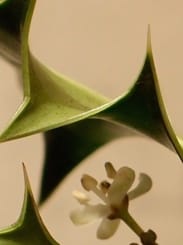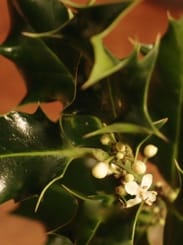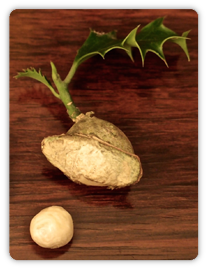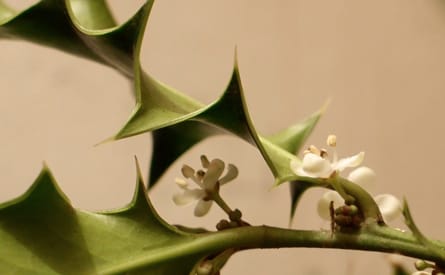

Holly (Ilex Aquifolium)
Proving date: 2015
Proving completed by: Misha Norland, Mani Norland & The School of Homeopathy
Common name : Holly
Download: Full proving Holly (lles Aquifolium)
Download: Proving rubrics
About Holly
Brave, no pain, forceful and focused, blood and bone.
There are powerful opposites in this remedy of merging? and withdrawing from the Divine . Patients needing Holly may feel hopeless and exhausted, confused and powerless, with an overwhelming sense of struggling against dark forces. They typically want to be left alone in their dark melancholic space, that has no light at the end of the tunnel. It is like a cold Winter without end. They feel detached and misunderstood. They may moan and complain, or become angry and violent as if in a bloody war zone of threat and betrayal. The use of the Bach flower remedy inclines the patient towards love and acceptance, and away from hatred, envy and jealousy. As one prover put it, 'The eruption of anger upset me because it was so sudden, so violent and so explosive. I needed to scream to let out this fiery rage.' The dynamic opposite state brings optimism and taking pleasure in the achievements and successes of others. In this state, Holly has boundless energy, and a sunny disposition, feeling attractive and sexy. They feel strong and brave, and highly productive. 'Happiness is like those palaces in fairytales whose gates are guarded by dragons: We must fight in order to conquer it.' Alexandre Dumas. The proving revealed a fascination with the colour red and blood. Provers wanted to buy red items and wear red clothes. There is? a bloody/metallic taste in the mouth. Sensations: gunshot-type pains that are sudden and intense. Pains feel icy cold and metallic; sharp, penetrative, piercing, needle-like, tearing and cutting; also pulsating, radiating and boring. Vertigo comes with 'creeping, circular, swaying dizziness.' There is heat and cold – burning inflammation, sweaty hot flushing, itching and tingling vs cold, heavy numbness and dull pain.
Holly
Holly is a genus of roughly 480 species of flowering plants and belongs to the family Aquifoliaceae. The species include evergreen and deciduous trees, shrubs and climbing plants, spread across the globe in many regions. Ilex aquifolium is the European holly, a mature slow-growing tree that can reach 15–25 m tall, and live for 300 years. The thin dark-brown bark of the tree is smooth and fleckled with brown blemishes. Holly is dioecious, with male and female flowers occuring on different plants. The flowers are small and greenish-white, with 4 petals. The smooth glossy leaves are dark green, leathery and oval with spikey prickles on the leaf margin. They are more spikey at the base of the tree for protection from animals. Older trees are more likely to have smoother leaves. Female flowers, once pollinated by insects, develop into bright red, hard, round berries, which remain on trees over the Winter months (if they're not eaten by birds or other creatures).
Mythology
Winter: As the red berries are largest and brightest in Winter, and the leaves are evergreen, holly has always been associated with Winter magic. An old tradition of bringing holly into the home in Winter, as a place for fairies to play, is echoed through the ages, to await the arrival of the Winter elf king Santa Claus. It was long regarded as unlucky to leave holly wreaths up after the Twelfth Night and that misfortune would strike those who dared to cut down or burn a holly tree. Some felt good luck would come from keeping a sprig from a church Yuletide holly wreath and so wreaths would be divided among church members. The Celts of the British Isles and Gaul believed the Holly king ruled over death and Winter, whereas the Oak king ruled over life and Summer. This ancient belief was preserved into medieval times in mummers' plays, and adapted to the Druidic revival and other pagan systems of faith in modern times. The Holly king found his way into Arthurian Legend as the Green Knight, who challenged Sir Gawain during a Yuletide feast, bearing a great wooden club made of a thick holly branch.
Scandinavia: Holly belonged to Thor (Viking god of thunder) and Freya (Viking goddess of the weather and seasons). The association with Thor's lightning gave rise to Norsemen and Celts planting it near their homes for protection. It seems natural enough that holly should be sacred to a god and a goddess when the trees are of 2 sexes. The Grimms' Fairy Tale of 'Mother Holly' tells the story of Frigga, and the ancient Earthmother, Hulta 'Elderberry'. In the tale of Mother Holly, her cat causes bad weather by eating her corn. When she discovers the devilry, she doesn't punish the cat because the sound of its stomach rumbling like thunder after eating the corn, pleased her. Although Mother Holly is a Winter death-bringing crone associated with holly as a Winter poisonous fruit-bearing tree, she also has a Spring-Summer life-giving aspect with the edible fruiting elderberry.
Ogham: Letter names of the Druidic ogham alphabet can be interpreted as names of trees, of which holly and oak are most primordial. They are regarded as 2 'kings' who exchange leadership on a yearly basis by engaging in symbolic battle. The Gaelic name for holly – 'tinne' – relates to the word 'tanist' meaning 'dark twin'. Oak rules from the time the light begins its ascent in December until the Summer solstice in June. Holly is the 'dark twin' who reigns during the waning light of the year, until Winter solstice.
Early Christianity: Holly has strong European pagan associations. It was deciduous until Herod's soldiers came to slay the baby Jesus and, at Mary's request in Winter, the tree became evergreen so that her infant could be hidden in the foliage. Another Christian legend states that the berries were once white, until touched by the blood of Jesus when a holly wreath served as his martyr's crown. The tree's association with druidry and elves was gradually assimilated into early Christianity after the Roman invasion of the British Isles. The sacredness of holly stands uninterrupted today, linking its association with Jesus and Santa, an elf king dwelling in the coldest most deathly and distant part of the Earth.
Germany: An old tradition has it that when the household's Christmas wreath is made of 'he-holly', the husband would rule the house for the coming year. However, if it were 'she-holly' (and for sake of the berries, it usually was 'she-holly'), the wife would rule the house.
Asia: In Shinto mythology the Japanese holly (Ilex crenata) held a similar position to that of holly in Europe. When the sun-goddess Amaterasu withdrew into her cave and refused to come out, the erotic clown-goddess Uzume hung a sacred jewel and mirror in the branches of a holly. She began to dance about the black-fruited tree in a humorously sexy manner to attract the attention of Amaterasu to come out for Spring to begin. In Japan, to this day, a lucky charm consisting of a glass ball etched with holly leaves, is used to symbolise Amaterasu's mirror, jewel and tree. Another popular charm used at New Year in Japan, is a holly leaf and skewer, to represent the Buddhist monk-god Daikoku. When he was about to be attacked by an Oni demon, a rat who dwelt with Daikoku as a friendly companion, hurried to the garden and brought back a holly branch for protection since an Oni will stay away from holly. To this day in Japan (and also in Europe), holly is hung on the front door of a house to repel evil. Chinese households were decorated with Ilex chinensis during New Year festivals.
South America: The Guarani foretold the coming of a tall, bearded, blue-eyed and fair-skinned god, Pa' i Shume, who taught many things to mortals, including how to make the stimulating and medicinal yerba mate beverage to give longevity and vitality, from the leaves of Ilex paraguayensis.
Jewish and Islamic tree lore: Holly is notably absent as it was not native to Israel or Arabia, and is not legitimately referred to in Torah or the Koran.
History
North America: For the Native American Indians, the American holly (Ilex opaca) symbolised courage and defence. It was grown around their camps to protect the tribe, and holly was attached to their warshields. Archeologists have found ritual shell-cups with holly residue dating to 1,200 bc.
The Romans: may have regarded holly as sacred, hanging Winter sprigs upon images of Saturn during Winter's violently erotic Saturnalia.
The wood of holly: is hard and as such, it was used in transport as wheels, joinery, cabinet making, engineering, mathematical instruments, wood engraving and veneering, and was fashioned to provide bobbins for the cotton mills of Lancashire.
Toxicity: The leaves, if eaten, can cause stomach and intestinal problems but the berries are especially dangerous if accidentally consumed by children attracted to the bright red fruits. Ingestion of over 20 berries may be fatal for a child. Holly can also be toxic to pets and livestock.
Medicinal uses: The leaves of Ilex aquifolium can be used to make tea and alleviate digestive disorders, water retention, jaundice, rheumatism, periodic fevers, measles and respiratory illnesses such as colds, coughs, flu and pneumonia. Holly leaves can also be used to treat dizziness and high blood pressure, and topically for sores and itching. Historically, the leaves of other holly species have been used by American Indians as a heart stimulant, laxative and to induce vomiting. The berries, when consumed, have emetic and diuretic qualities and will empty and cleanse the bowels. In South America, yaupon tea (made from the leaves of Ilex dahoon, Ilex cassine and Ilex vomitoria) was once administered in a purification ritual. The bark was used to treat malaria and epilepsy.
Holly Bach flower remedy: The desire for love is programmed into every cell of our being however, when the need to give and receive love is denied, the negative holly state emerges with extreme disappointment, jealousy, hatred, envy, resentment, malice, and a desire for revenge. When jealousy becomes 'morbid', love can be extinguished. Edward Bach said, 'Holly protects us from everything that is not Universal Love. Holly opens the heart and unites us with Divine Love.' The soul quality of holly is that which we all desire – the ideal human state. In its positive state, individuals are able to live in inner harmony, taking pleasure in the achievements and successes of others, freely accepting and feeling love that flows toward them, having a sense for the Divine scheme of things.
The proving
Both male and female flowers, along with 3 partly crushed burrs, were placed under vodka in a medicine bottle. Whilst crushing the burrs with a pestle, the bowl cracked, demonstrating the extreme density of the slow-growing holly wood.
After taking the proving substance, and during a meditation that followed, one prover saw an image of someone coming into the room; a stranger. He asked them what they saw and was told, ‘They see a green leaf in the middle of the room, it is large and it is shaped like a dragon. Strong and powerful. Dragons fly and they breath fire’. The mythical dragon is an interesting metaphor for holly as it is green and spikey, brave, strong and defiant. It is also calm and carefree and, despite seeking connection, it becomes aloof and isolated. It is a solitary creature that is misunderstood. Often, there is something precious that Holly is protecting, which they will defend with fiery anger and action. Images of blood red war and death are essences of both the dragon and the proving. Deep grief about recent and old deaths came up, and for one prover, a fear of her husband, sister and kittens dying. Unsurprisingly, there was also exhaustion and struggle, described by a prover as, a 'strong sense that I must carry on, struggle on and that somehow I can push through all this.' Forgetfulness ensued, 'a sort of deconstruction of mental structures, preconceived notions, mental patterns (haze feeling, inability to focus, speech not coming out right, aimless wandering, absent-mindedness etc.)', then indifference and withdrawal. The indifference was a mental detachment, reported by a prover as, 'being behind a curtain ... mental exhaustion and despair from having to deal with those for so long and not seeing any light at the end of the tunnel ... no desire to contact anyone; as if all my energy was pulled back in from out there and with it I had a new sense of power; it felt as if by trying to connect with others I would just be scattering my energy and losing my strength'. Along with these themes, a calm, loving, connected and carefree nature was also experienced, with provers feeling focused, busy, energised and, like the dragon, ready for action: 'full of energy, feeling attractive and sunny, confident and patient'.
Holly represents truth and speaks to the fierce capacity of the human soul to take the descent into the underworld, bringing inner light into depressed darkness. The tree, with its ability to germinate without sunlight, favours dark, moist conditions that are more strongly related to the downward Earth pole. Its stiff, pointed leaves are not unlike thorns or 'spears'. Holly yields a hard, white close-grained wood that imparts a quality of solidity and impermeability, as it stands in the depths of Winter, impervious to cold and darkness, with its sombre colour.
Download: Full proving Holly (lles Aquifolium)
Download: Proving rubrics

Brave - Loving - Indifference - Action - Depressed - Forgetfulness - Struggle - Fiery anger - War - Blood red
Proving Themes

Kingdom: Plantae
(unranked): Angiosperms
(unranked): Eudicots
Order: Aquifoliales
Family: Aquifoliaceae
DC. ex A.Rich.
Genus: Ilex Aquifolium
Kingdom Taxonomy
"Happiness is like those palaces in fairytales whose gates are guarded by dragons: We must fight in order to conquer it."
Alexandre Dumas

.jpg)
